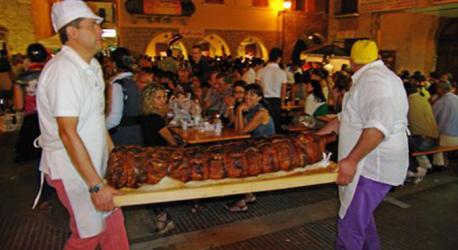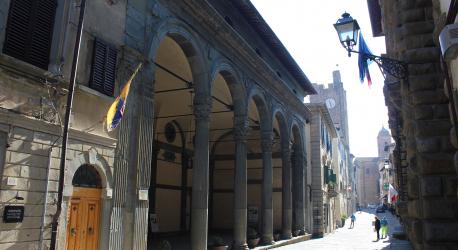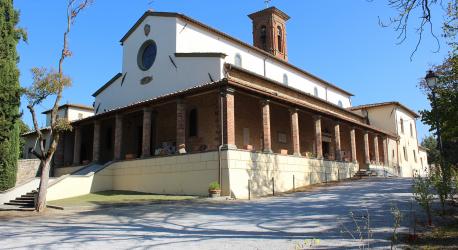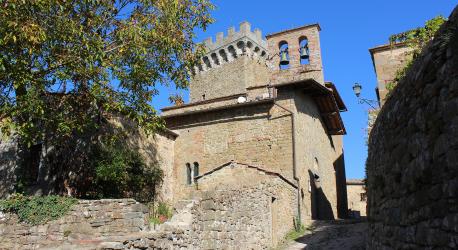Located on the western side of the Valdichiana Arezzo, lying on a mountain in front of the valley of the Esse stream, Monte San Savino is a characteristic Etruscan village whose population dates back to the fourth century BC, the period to which the famous necropolis of Castellare and Case Sant'Angelo date back.
Little is known about the history of Savina in Roman times, but an archive document from 1222 tells how a senator, head of four consuls representing the districts, ruled the town. Subjected to the domain of the Ubertini Ghibellini d'Arezzo, Monte San Savino sided with the Guelph faction also participating in the so-called "jousting from Toppo" against Arezzo.
Following the battle of Campaldino, Monte San Savino becomes a real Guelph bulwark of the Florentine district in Valdichiana. However, the Arezzo reconquest and the Tarlati domination forced the Guelphs to leave and take refuge on the Vertighe hill, until 1337 when, following their return, the current urban spindle structure, typically medieval, of the historic center was probably determined.
A center of high cultural fervor during the Renaissance, Monte San Savino was the home of excellent artists such as Andrea Sansovino, Niccolò Soggi, Stefano Veltroni and the Vasarian Orazio Porta. Known for its ceramics and its agricultural and oil production, Monte San Savino can be considered by tourists one of the most modern and technological municipalities of the Valdichiana thanks to the free wifi network that crosses the entire historic center and allows visitors to geo- locate places of interest and craft shops.

Monte San Savino is famous in Italy for its porchetta. The traditional "Sagra della Porchetta", organized by the Proloco association, is today an almost indispensable event even for the inhabitants of Arezzo who, on the second weekend of September, reach the historic city center every year to taste what all is considered an unmatched delicacy. Since June 2009, Monte San Savino is also the holder of the Guinness World Record, won for making the longest porchetta in the world.

Of great popular importance is "The night of Count Baldovino", an unmissable re-enactment which, in the last week of June, recalls the investiture of the Savinese nobleman in 1550. Culminating in a great village festival, the event finds its moment highlight in the famous Palio dei Quartieri, during which the members of Jalta, Castiglia, Porticciolo Guglielmi and San Giovanni compete in four competitions. Inaugurated in 2012, these consist of the famous games of "Pallone grosso", "Caccia di Monte", "Tiro alla Fune", and the long-awaited gastronomic competition.

In the historic city center, the Logge dei Mercanti stand out, an elegant and majestic sixteenth-century building in pietra serena. The structure overlooks the Palazzo del Monte, a Renaissance aristocratic residence with well-kept hanging gardens that houses the Town Hall, and has five beautiful arches resulting from the rearrangement of Monte San Savino at the end of the 15th century.

Dedicated to the Madonna delle Vertighe, named patron of the Autostrada del Sole in 1964 by Pope Paul VI, the sanctuary was originally annexed to a Camaldolese priory. Rebuilt around the middle of the 15th century by incorporating a medieval chapel whose apse, according to the legend, bears the fresco of the "Madonna in almond", object of popular devotion well rooted in the collective imagination of the place. Having become a destination for pilgrims from all over Italy since the sixteenth century, the Sanctuary now houses works belonging to the artistic heritage of Montigiano such as the fresco depicting the Nativity of the Virgin, signed by Bernardino Santino and the fresco by Orazio Porta representing the Assumption of the Virgin.

On the hills overlooking Monte San Savino and the Val di Chiana, surrounded by a dense forest, lies a perfectly preserved fortified village that still maintains its original medieval identity. The castle of Gargonza is an oasis of tranquility that will fascinate and amaze every visitor with its crenellated tower, the walls, the thirteenth-century gateway, the thirteenth-century Romanesque church and the narrow alleys enclosed between historic houses, offering a suggestive journey back in time.
TheAssociated paths of MONTE SAN SAVINO






